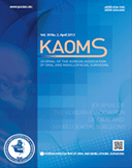Journal of the Korean Association of Oral and Maxillofacial Surgeons
- P-ISSN2234-7550
- E-ISSN2234-5930
- SCOPUS, KCI, ESCI
 ISSN : 2234-7550
ISSN : 2234-7550
Surgical extraction of a sublingually-displaced retained root with the aid of a magnetic field-based dynamic navigation system: a case study
Seung-Eun Lee (Department of Oral and Maxillofacial Surgery, Hallym University Sacred Heart Hospital, Anyang)
Sung-Ah Che (Department of Oral and Maxillofacial Surgery, Hallym University Sacred Heart Hospital, Anyang)
Sang-Yoon Park (Department of Oral and Maxillofacial Surgery, Hallym University Sacred Heart Hospital, Anyang)
Soo-Hwan Byun (Department of Oral and Maxillofacial Surgery, Hallym University Sacred Heart Hospital, Anyang)
Byoung-Eun Yang (Department of Oral and Maxillofacial Surgery, Hallym University Sacred Heart Hospital, Anyang)
Sangmin Yi (Department of Oral and Maxillofacial Surgery, Hallym University Sacred Heart Hospital, Anyang)
Abstract
The submandibular displacement of a mandibular third molar residual root presents major challenges to oral and maxillofacial surgeons due to the proximity to critical anatomical structures such as the lingual nerve and sublingual artery. Preoperative imaging can approximate the location of the residual tooth root; however, accurately determining its exact position is difficult because of the dynamic nature of the mandible and the difficulty of realtime synchronization of imaging. This study presents the successful extraction of a residual mandibular third molar root in a 67-year-old female patient achieved using a magnetic field-based navigation system. The sublingually-displaced residual root was localized using the navigation system, marked using a virtual implant placement, and positioned by a hand piece using synchronized real-time sensor data. The root was successfully removed with a minimally-invasive approach. No complications occurred postoperatively, and follow-up showed no major issues. Due to the small size of the marker, ease of calibration, and independence from visual obstacles, magnetic field-based navigation systems are a promising tool for the removal of residual roots displaced into adjacent soft tissue.
- keywords
- Tooth extraction, Surgical navigation systems, Minimally invasive surgical procedures
- Downloaded
- Viewed
- 0KCI Citations
- 0WOS Citations